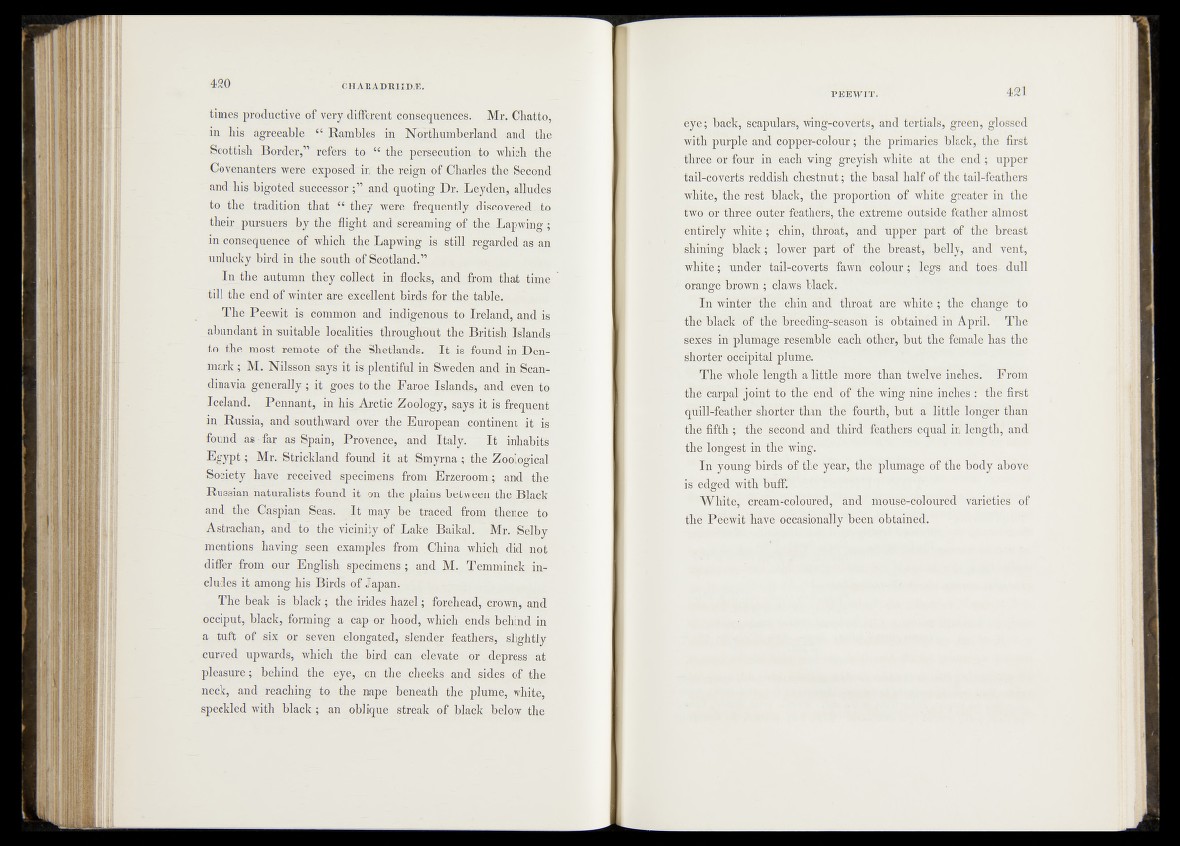
times productive of very different conseqriencbs. Mr. Clmtto,
in his agreeable i( Rambles in Northumberland and tip
Scottish Border,” refers to “ the persecution, to .which: the
Covenanters were exposed in the reign of Charles the Second
and his bigoted successor jtnd quoting Dr. Lgydeji, alludes
to the tradition that “ they. v?£ie frequentlyf SisG^yered, to
their „pursuers by the flight and streaming Lapwing!
inconsequence, of which the Lapwing is still regarded as an
unlucky bird in the south of Scotland.”.^
In the autumn they collect in flocks,’ and „from that time
till the end of .winter are excellent birdsfor the table.
The B.eewit is . common and indigefaon%to^Tre1|a,n d. and is
abundant in suitable localities throughout the Britisbrljl^jds
to Jthe most remptg^pf^thefj-Shetlands. I t ^pfound:in,. Den-
mark; M.'^M^son-saySdt isqffentiful.in Sweden and in p p h s
<bna via. generally; it .go.es to thej^aroe Islands^ and eyenytp
Iceland. . Pennant, in his^Arctic .Zoology,:says ifoisjgequcmi.
in Russia, and southward over ^the^European _ c^Mtinentpit, .is
founds ns. , far as Spain, Provej^e^and Italy. “ ,in ^ h to
E g y p t; Mr.Strickland found it at, Smyrnay,;|h^^^&gic,ajl
Society have received, Specimens from Erferpom^; and die.
Russian, naturalistsTolind ifc^on^tjte plains between th e ^ a c k
and the*. Caspian, eSeafei - I t may-vbc -traced from t h ^ ^ J t o
Asferach^l, and jgp the' vicinity of La.lTe Baikal,
mentions having seen examp^ f e f rom China which did nqj;
differ from ourf; English spedmeqsj. and M. Temm#yek includes
it among his Birds of Japan.
The beak-.is black; the irides hazel; forehead, crown, and
pcciput, black,^forming a cap-or hood, whicE^nds.behind in
a tuft of six or seven elongated, slander feathers, slightly
curved upwards, whicli the-bird can efeyate^, or ^depress-at
pleasure; behind the on thepheeks and,* sides., of the
neck, a n d ‘reaching to. the nape beneath, .the plume,^.white,
speckled with black ; an .-oblique streak of; black, below the
'èfe; back, scapulars, wing-coverts, and tertials, green, glossed
with purple aria copper-qolour; the primaries black, the first
three ’-or four in each wing greyish white at the en d ; upper
tail-covertS reddish chestnut; the basal half of the tail-feathers
white, the rèst' bliek, ‘ the proportion of white greater in the
two or three oriterffëatnèrs, the extreme outside feather almost
entirely white^EchmJ, ‘throat, and upper" part of the breast
Shining black; lower part of the breast, -bellyy and vent,
white; iarid®rtaS|6overts fawn' colour; legs and toes- dull
orange brown '; .claws black.
In winter"me:' chin arid throat are white; thé change to
|®tep!fraek‘ o"f '\li'e^bna'ding4s;soqJ is obtained'in April; Tbe
sexes in „plumage1' resemblrif each other, but the female has the
shorter ‘ ogeipi Lai" plumefP
The wn^oren^tK a 'litSKiii'^^ than twelve inches. From
th ^ ^ ^ B w ip g^8iSfe>’ eirerdrTfle wing nine indR^pthe first
qnill-featlfer shorter t'hln WxT:fourth, but a little longer tban
tnê^fifrarr Wepe^nff and third feathers equal in length, and
jtWè ldfigCbt in-TOe winger®
In ’yotïng^uilÉs "of tl&',‘y^rir, the plumage of the body above
jfjgediged1 wiM buff."
Whi^^cream-coTOffi?éÖ,, and fiïoüse-coloured varieties of
tlte Ptewit haVè occasionally berin obtain'ellf^